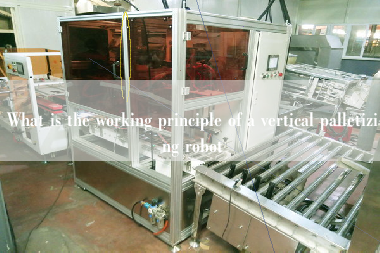With the continuous development of industrial automation, robots have become an indispensable part of industrial production. Palletizing robots, as a commonly used robot, are also constantly developing and improving. Among them, vertical palletizing robots, as an efficient and intelligent robot, have attracted more and more attention. So, what is the working principle of a vertical palletizing robot?
1. Overview of vertical palletizing robot
The vertical palletizing robot is a robot that can automatically stack items. It is mainly used for palletizing items on production lines. The vertical palletizing robot can automatically palletize items into specified shapes and heights according to preset procedures, thereby achieving efficient and precise production.

2. Working principle of vertical palletizing robot
The working principle of a vertical palletizing robot is mainly divided into the following steps:
1. Identification and location of items
Vertical palletizing robots first need to identify and locate the items to be palletized. This step is usually achieved through machine vision technology. Machine vision technology can identify and locate items with high precision, thereby ensuring that the vertical palletizing robot can accurately palletize items.
2. Design of palletizing plan
After identifying and positioning the items, the vertical palletizing robot will design according to the preset palletizing plan. The palletizing plan usually includes the stacking method of items, the height and number of stacks, etc. When designing a palletizing plan, vertical palletizing robots need to consider factors such as the size, weight, and shape of the item to ensure the stability and safety of palletizing.
3. Execution of palletizing
After designing the palletizing plan, the vertical palletizing robot will begin to perform palletizing operations. During the palletizing process, the vertical palletizing robot will stack the items according to the palletizing plan according to the preset program. During the stacking process, the vertical palletizing robot will adjust the speed and intensity of palletizing according to factors such as the size and weight of the item to ensure the stability and safety of palletizing.
4. Completion and output of palletizing
After the palletizing operation is completed, the vertical palletizing robot will output the stacked items to the designated position. During the output process, the vertical palletizing robot will output the items in the specified order according to the preset program, thereby ensuring efficiency and accuracy of production.
3. Application of vertical palletizing robots
Vertical palletizing robots are widely used in various production lines, such as food, medicine, chemical, electronics, automotive and other industries. Vertical palletizing robots can greatly improve production efficiency and quality, reduce manual operation errors and labor intensity, thereby reducing production costs and improving the competitiveness of enterprises.
4. Development trend of vertical palletizing robots
With the continuous advancement of technology, vertical palletizing robots are also constantly developing and improving. In the future, vertical palletizing robots will be more intelligent, efficient and flexible. Vertical palletizing robots will pay more attention to human-computer interaction, and pay more attention to independent learning and independent decision-making, so as to better meet the needs of the production line.
Summary:
Vertical palletizing robot is a kind of efficient and intelligent robot, which can automatically complete the stacking of items, thus improving production efficiency and quality, reducing production costs and improving the competitiveness of enterprises. The working principle of vertical palletizing robot mainly includes the identification and positioning of articles, the design of palletizing scheme, the execution of palletizing and the completion and output of palletizing. In the future, vertical palletizing robots will be more intelligent, efficient and flexible to better meet the needs of production lines.
